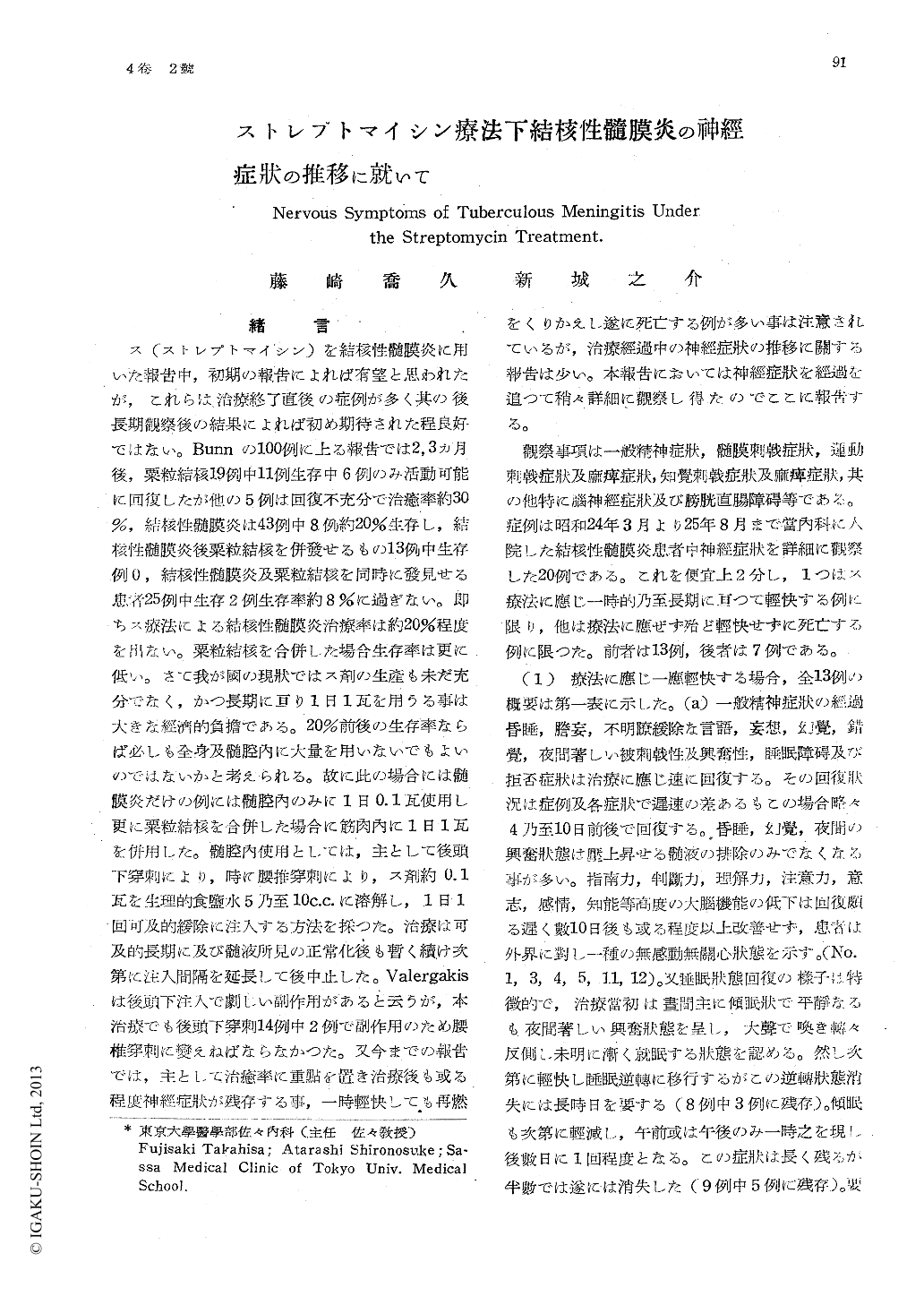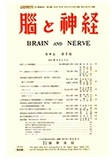Japanese
English
- 有料閲覧
- Abstract 文献概要
- 1ページ目 Look Inside
緒言
ス(ストレプトマイシン)を結核性髄膜炎に用いた報告中,初期の報告によれば有望と思われたが,これらは治療終了直後の症例が多く其の後長期觀察後の結果によれば初め期待された程良好ではない。Bunnの100例に上る報告では2, 3カ月後,粟粒結核19例中11例生存中6例のみ活動可能に回復したが他の5例は回復不充分で治癒率約30%,結核性髄膜炎は43例中8例約20%生存し,結核性髄膜炎後粟粒結核を併發せるもの13例中生存例0,結核性髄膜炎及粟粒結核を同時に發見せる患者25例中生存2例生存率約8%に過ぎない。即ちス療法による結核性髄膜炎治療率は約20%程度を出ない。粟粒結核を合併した場合生存率は更に低い。さて我が國の現状ではス剤の生産も未だ充分でなく,かつ長期に亘り1日1瓦を用うる事は大きな經濟的負擔である。20%前後の生存率ならば必しも全身及髄腔内に大量を用いないでもよいのではないかと考えられる。故に此の場合には髄膜炎だけの例には髄腔内のみに1日0.1瓦使用し更に粟粒結核を合併した場合に筋肉内に1日1瓦を併用した。髄腔内使用としては,主として後頭下穿刺により,時に腰推穿刺により,ス剤約0.1瓦を生理的食鹽水5乃至10c.c.に溶解し,1日1回可及的緩除に注入する方法を採つた。治療は可及的長期に及び髄液所見の正常化後も暫く續け次第に注入間隔を延長して後中止した。Valergakisは後頭下注入で劇しい副作用があると云うが,本治療でも後頭下穿刺14例中2例で副作用のため腰椎穿刺に變えねばならなかつた。又今までの報告では,主として治癒率に重點を置き治療後も或る程度神經症?が残存する事,一時輕快しても再燃をくりかえし遂に死亡する例が多い事は注意されているが,治療經過中の神經症?の推移に關する報告は少い。本報告においては神經症?を經過を追つて稍々詳細に觀察し得たのでここに報告する。
觀察事項は一般精神症?,髄膜刺戟症?,運動刺戟症?及麻痺症?,知覺刺戟症?及麻痺症?,其の他特に腦神經症?及び膀胱直腸障碍等である。症例は昭和24年3月より25年8月まで當内科に入院した結核性髄膜炎患者中神經症?を詳細に觀察した20例である。これを便宜上2分し,1つはス療法に應じ一時的乃至長期に亘つて輕快する例に限り,他は療法に應ぜず殆ど輕快せずに死亡する例に限つた。前者は13例,後者は7例である。
The authors have made observations concerning mainly to the nervous symptoms about the streptomycin treatment of 20 adults with tu-berculous meningitis. 13 of them recovered temporairlyor completely during the treatment of 33~238 days, and the other 7 died soon inspite of the treatment 2~12 days. Each patient was injected 0.1gm. of streptomycin intrathecally and some of them with compli-cated miliary tuberculos's were also given 1.0gm. of streptomycin intramusculary once a day for a considerable period.
(1) Following nervous and mental symptoms were specially observed in the former 13 pa-tionts (a) General psychological symptoms such as coma, deliria, delusion, hallucination, irritability, excitability, insomnia and brady-lalia vanished in 4 or 10 days. But indication, understanding, judgement, intention, feeling and intelligence belonging to the function of cerebrum did not recover very rapidly, not improving beyond a certain degree. Thus some patients showed the aspect of apathy, charac-teristic of the prolonged tuberculous mening-itis. At first drowsiness in the daytime was followed by nocturnal excitement. Such inver-sion of sleep persisted for a considerable period. (b) Severe headache and bradycardia due to meningeal irritation subsided soon after the removal of the cerebrospinal liquor. But slight headache remained for as long as 40 days and sometimes longer. Nausea and vomiting ordinarily subsided sooner or later, but after- wards these were evoked sometimes by the intrathecal use of streptomycin. (c) Signs of motor system. Stiffness of neck did not ligh-ten for a long time, but the strain of abdo-minal muscles subsided soon. The intensity of the Kernig's sign parallelled with the situa-tion of the meningitis. Cog-wheel like rigidity of hand and cubital joint remained for a while. The sign of Babinski had been positive in 7 cases at the beginning, and was elucidated in every patient at a period of the disease. (d), Sensual signs. Hyperacusis an hyperesthesia subsided soon. But radial nerve remained most sensitive against pressure for a long time. (e) All the 4 patients who had not the sym-ptoms of cranial nerves recovered, while the other 9 with any of those died eventually.
(2) In some of the cases the relapse occurr-ed from one to three times during the treat-ment. After the relapse meningeal symptoms may subside, but the symptoms due to dest-ruction of cerebrum remains. After such re-lapses some of the patients show decebrated state and die eventually.
(3) All the 7 patients who died soon against the treatment were therapied after they had gone into the paralytic stage. In these the. involvement of many cranial nerves and the stimulations of motor system such as fumbl-ing and fasciculous contraction were observed from the beginning of the treatment.

Copyright © 1952, Igaku-Shoin Ltd. All rights reserved.


